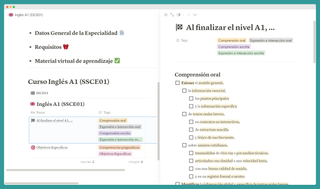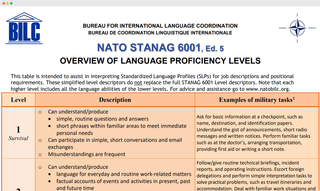UN Language Framework Definitions
UN Levels of Language Competence Definitions
- Accuracy
- Accuracy refers to how correct learners’ use of the language system is, including their use of grammar, pronunciation and vocabulary.
- Adequate
- Satisfactory or acceptable in quality or quantity.
- Appropriate/ Appropriately
- Suitable or correct for a particular situation or set of circumstances.
- Context/Situation
- Context refers to the macro-level circumstances surrounding a communication act, such as the time, place, status of interlocutors, and other facors which affect the interaction. A group of contexts will make up a given domain.
- Situation refers to the micro-level communicative functions which take place in a variety of contexts.
- Domain
- A domain defines the area in which the interaction or communication takes place.
- The UN Language Framework takes three domains into consideration:
- the personal, public and professional domains, throughout the Organization.
- Therefore, all domains are to be understood primarily in the UN context.
- The personal domain concerns interpersonal relationships, individual social practices, discussions with colleagues or friends on personal matters, such as likes or dislikes, hobbies, housing, family, etc.
- The public domain refers to activities taking place within, and extended to, the general public, including transactions of various
kinds, such as administrative tasks, dealing with public services, engaging in cultural and leisure activities, etc. - The professional domain encompasses everything concerned with a person’s activities in the exercise of their occupation, mainly related to international organizations. It also includes educational elements, especially if they are related to training and development.
- Efficiency
- The ability to convey the intended message as effectively as possible, while also maintaining an appropriate register.
- Everyday/Routine
- Everyday: mostly familiar contexts or situations, occurring frequently.
- Routine: elements of verbal, and non-verbal, communication that are almost formulaic and can be performed automatically, such as repetitive tasks.
- Facility
- The ability to do something well without a lot of difficulty or effort.
- Flexibility
- The ability to readily improvise and adapt language to changing circumstances without advance preparation, including the communication form, whether written or spoken.
- This includes register (formal, informal, etc.), b (neutral, ironic, etc.) and vocabulary (technical, vernacular, etc.).
- Fluency
- The ability to use a language automatically, spontaneously and without much hesitation, such that the communication goal is achieved without undue strain on anyone involved.
- General/Ordinary
- General: not specialized or limited in range of subject, application, or activity. It also conveys the idea of being accessible to a large public.
- Ordinary: commonplace; not different, special, or unexpected in any way. It also conveys the idea of familiar, frequent, everyday activities.
- Key Points
- These are the principal or most salient ideas in a text. You can understand the key points in a text without necessarily understanding all the details in that text.
- Matter
- A matter is a subject or situation under consideration. For the purposes of clarity, matter could be replaced by topic, a more general concept.
- Models/Templates
- Model: an existing example of a text, i.e. an email, an article, a recording, etc., that can be used as a reference for generating similar ones.
- Template: a highly structured text form or layout, typically with minimal content, used to generate copies or new texts with only content related modifications.
- Ordinary/General
- Ordinary: commonplace; not different, special, or unexpected in any way. It also conveys the idea of familiar, frequent, everyday activities.
- General: not specialized or limited in range of subject, application, or activity. It also conveys the idea of being accessible to a large public.
- Precision
- This includes accuracy but goes beyond the mere absence of errors to include exactitude and specificity.
- Reference Resources
- Any source that provides help to better prepare, understand or produce a linguistic message.
- Examples of most commonly used reference resources:
- authoritative or official works,
- i.e. dictionaries, encyclopaedias, glossaries, etc.
- tools such as voice recognition, digital correctors, online references, etc.
- people who provide help or feedback on the linguistic message
- authoritative or official works,
- Relay/Summarize
- Relay: to receive and transfer information.
- Summarize: to provide a brief restatement of the main ideas of a written or oral text.
- Routine/Everyday
- See “Routine/Everyday” above.
- Situation and Context
- Situation refers to the micro-level communicative functions which take place in a variety of contexts.
- Context refers to the macro-level circumstances surrounding a communication act, such as the time, place, status of interlocutors, and other factors which affect the interaction. A group of contexts will make up a given domain.
- Social Agent
- Language learners/users, as social agents, are members of society who have tasks to accomplish in a given set of circumstances and in a specific environment.
- These tasks are often language-related but not exclusively so.
- Social agents collaborate, negotiate meaning, arrive at consensus, and communicate effectively both orally and through various text forms, thereby developing plurilingual and pluricultural competence, as well as developing communication strategies.
- Standard (spoken or written)
- (Short for ‘standard varieties of a language’)
- Standard varieties are generally understood and used by a large group of people.
- They are usually encoded in reference works and used primarily in semi-formal and formal contexts, and in public discourse, both spoken and written.
- Summarize/Relay
- See “Relay/Summarize” above.
- Templates and models
- See “Models and templates” above.
- Texts
- Any passage of written or spoken words, of whatever length, that forms a connected whole to express a unified message.
- Examples of written texts include reports, proposals, memorandums, letters, emails, press releases, text messages, newsletters, posters, essays, etc.
- Examples of spoken texts include news stories, interviews, dialogues, monologues (e.g., a speech or a lecture), phone conversations, discussions, etc.




